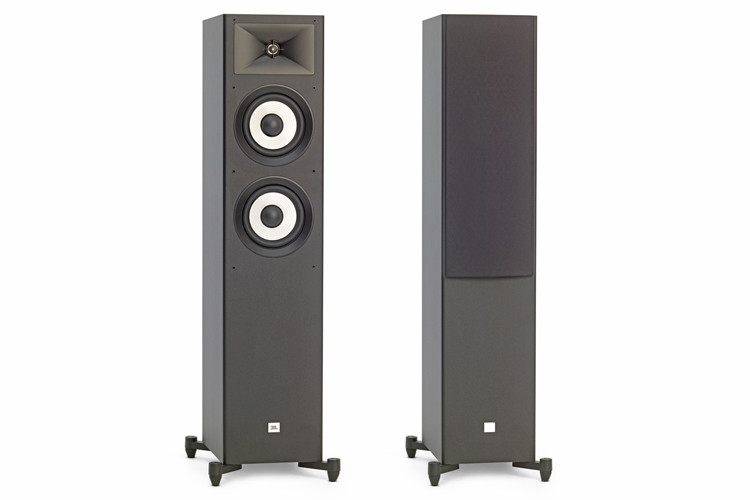
The engineering that goes into most modestly-priced speakers is often conspicuous in its absence, but from the instant you open their cartons, the JBL A180s display quality and performance far beyond what you’d expect. The engineering resources of the Harman group have been applied generously to the Stage A180s and those efforts are clearly audible.
JBL STAGE A180 LOUDSPEAKER
- The JBL A180 speakers include a crystal-clear horn-loaded tweeter
- The bass range can be tuneful, tight, and extended
- The midrange clarity gives even complex music a very detailed presentation
- The speakers image well from a variety of different positions
- Woodgrain vinyl is available for those who don’t care for industrial black
- Dual-terminals with jumpers allow for bi-wiring or bi-amplification
- Both carpet-piercing spikes and rubber feet are included
- Optional outriggers are included
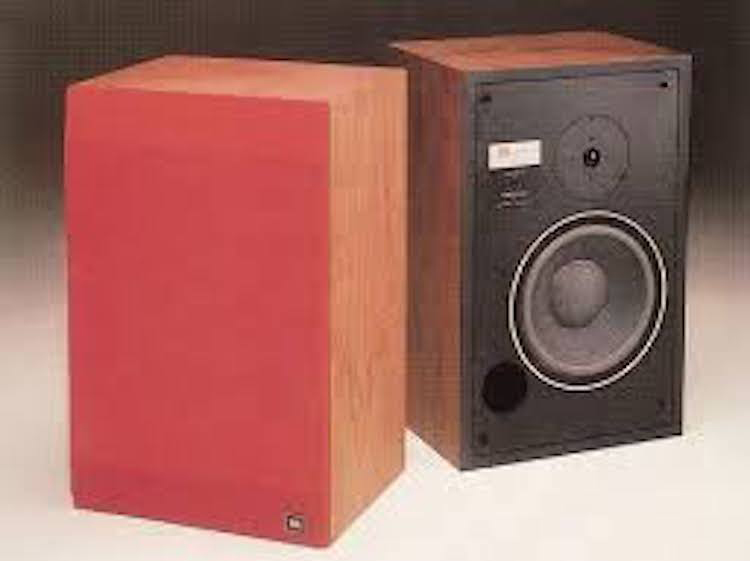
I have a soft spot in my heart for JBL speakers. The very first pair of “good” loudspeakers I bought was purchased in the day when one had to choose between “New England Sound” as personified by Acoustic Research speakers, or “West Coast Sound” as personified by JBLs. As a young man in my off-campus apartment, I opted for the fun of the California sound, and bought an oak pair of JBL L40 speakers (with the burnt orange grills). I still remember the smell of the new-sawn cabinet wood, the way that the speakers spruced up the looks of my modest apartment, and the way that my friends and neighbors came by to admire the speakers and enjoy their sound.
Description:
2.5 way, dual 6.5″, 1″ aluminum tweeter floor standing loudspeaker
Woofer/Midrange:
2 x 6.5″ (165mm) white polycellulose low-frequency woofers
Tweeter:
1″ (25mm) Aluminum Dome Tweeter with new High Definition Imaging (HDI) Waveguide
Recommended Amplifier Power:
20 – 225W
Frequency Response:
40Hz – 40kHz
Sensitivity:
90dB @ 1M, 2.83V
Nominal Impedance:
6 Ohms
Crossover Frequencies:
1.4kHz, 2.0kHz
Enclosure Type:
Bass-Reflex via Rear-Firing Tuned Port
Dimensions (W x D x H):
230 x 295 x 1000mm (9.1 x 11.6 x 39.4 inches)
Weight:
38.03 lbs (17.25kg)
Price:
$349.95 each (USD)
Company:
SECRETS Tags:
floor-standing speaker, jbl, tower speaker, 2018, 2.5 way, Speakers Review 2018
- JBL 4367 Studio Monitor speakers
- JBL Studio 290 floor-standing speakers
- JBL LS80 floor-standing speakers
I’m happy to say that after all these years, the excitement of the “JBL sound” is still with us. Of course, the JBL Stage A180 tower speakers are technically far better than my L40s were, and in every way. The A180’s horn tweeters lack the brightness peak of the earlier JBLs, the midrange is more refined, and the bass extends far deeper. And best of all, adjusted for inflation, I think that the new A180 towers actually cost less!
The JBL Stage A180 tower loudspeakers came in boxes with shipping damage (no surprise, and no fault of JBL – ALL shippers seem to damage about 50% of all large packages). But despite the damaged boxes, the JBL Stage A180 speakers inside were in perfect condition. This was my first indication that Harman International used more than the usual diligence in the design and packing of their speakers.
And I must say that I was pleasantly surprised by the cool white woofers, reminiscent of the classic JBL L-100 studio monitors!

The next surprise I got was when attaching the outriggers to the bottom of the speakers. Most manufacturers, including those whose speakers sell for 10 times or more the price of the JBL A180s, provide a flat outrigger that must be aligned with the holes on the bottom of the speaker before attachment. The JBLs, however have a slight circular indentation routed into the speaker bottom where the attachment bolts are to go, and the plastic outriggers have a matching raised circular surface that “catches” in the speaker bottom. This not only provides easy and indexed alignment, but also perfect centering for starting the attachment bolts in their holes. It’s a small convenience, but it’s indicative of the extra design care used by JBL for these A180 speakers.
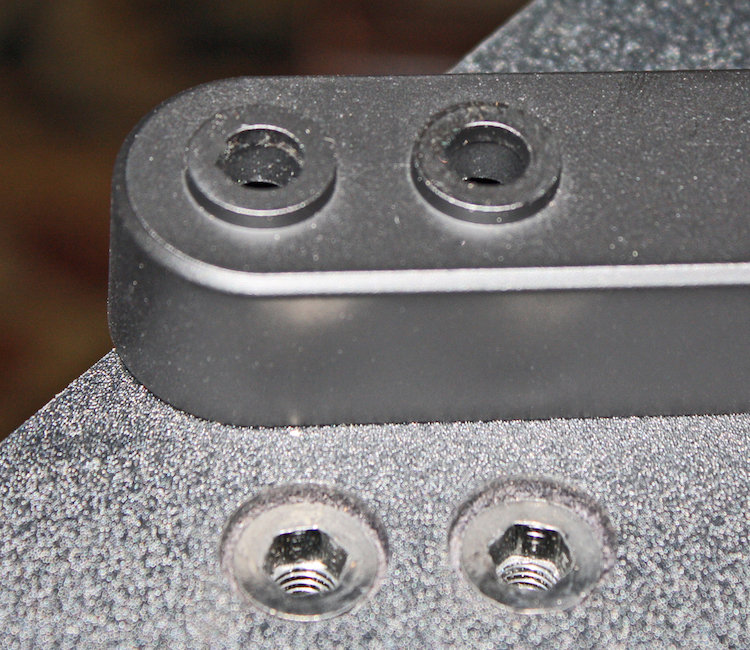
The JBL Stage A180 speakers also offer dual speaker-wire binding posts with removable jumpers between the terminals. This means that the jumpers can be removed should one wish to bi-wire or bi-amplify the speakers. The terminals are well-made and have brightly colored red and black thumbscrews, ensuring that the speaker wires won’t accidentally be installed out of phase, even in dim light.
The JBL 1” metal-dome tweeter resides in a shallow horn (or a “High Definition Imaging Waveguide,” in JBL-speak) for better dispersion. And this tweeter is one of the major strengths of the JBL Stage A180 speaker. Many “audiophiles” turn their noses up at horn-loaded tweeters, thinking of them as only good for public-address and “mid-fi” use. However, some of the most expensive speakers in the world, specifically the Magico Ultimate III ($600,000 per pair, unless they’ve gone up again since I checked) use horn tweeters. And I’ve yet to meet any “audiophile” who claims that those Magico speakers are “mid-fi.”
I’ve always liked the sound of horn-loaded tweeters myself, including the antediluvian Electro-Voice T-35. Those tweeters produce a more realistic brass cymbal sound than do the vast majority of metal dome tweeters. The latter often seem to have too much high treble “air” and not enough lower-treble emphasis, although much of that perception may just be resonances (listen to just about any metal-dome-tweeter to hear this effect).
Secrets Sponsor
The horns in the JBL Stage A180 speakers get the treble right. They hit exactly the sweet spot between horn articulation / accuracy and horn brightness. The dispersion is exceptional, and the treble is well balanced from just about any reasonable listening position or speaker orientation in the room.
The bass of the JBL Stage A180 speakers is more difficult to characterize. When powered by my (normally neutral) Arcam FMJ AVR550 receiver of roughly 100 watts per channel, the speakers sounded very, very prominent in the bass and not terribly tight. I tried moving the speakers toward and away from the back wall, but in each location, the heavy bass was still evident.
I then connected the A180s to my Emotiva XPA-2 (generation 3) power amplifier, without changing their room positions, and instantly the bass boom disappeared while the speakers were now significantly more capable of resolving bass notes’ pitch definitions. But with these improvements came a noticeable loss of low-bass. In fact, with the Emotiva amplifier, I opted to also fire up my PowerSound Audio subwoofer. It provided the bass that the Emotiva-JBL combo lacked. Don’t get me wrong – in a smaller room the Emotiva-JBL combo might be a perfect fit, but in my largish listening room, that pairing just sounded slightly bass-thin.
I speculate that the A180 may be somewhat more sensitive to amplification than many of the other speakers I’ve reviewed. Note also that I make this observation despite the fact that I normally listen at significantly lower volumes than most.
The JBL Stage A180 speakers also come with both rubber feet and spikes. Either of these can be attached directly to the bottoms of the speakers or inserted in the (supplied) outriggers for greater stability.
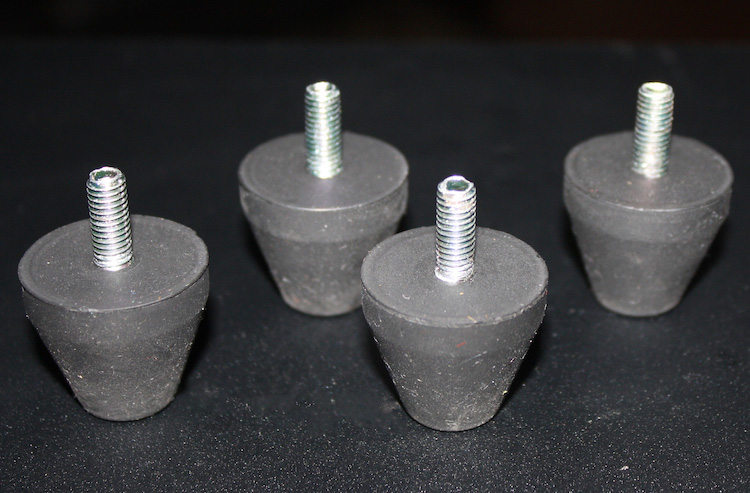
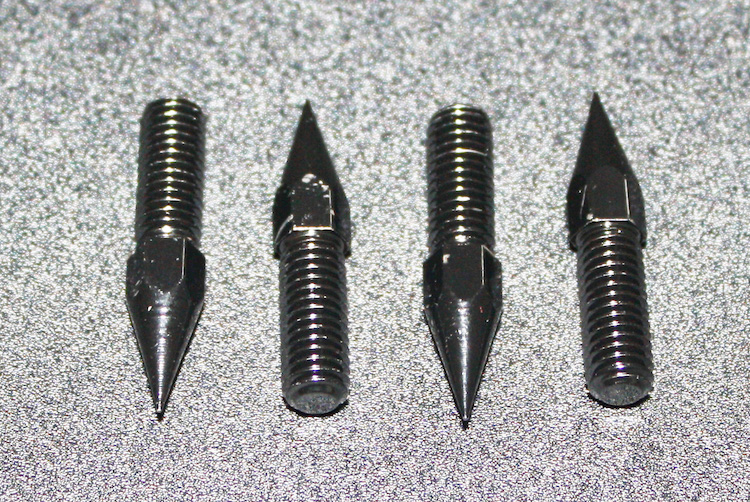
My review pair of speakers was finished in Industrial Black, but a woodgrain option is available that I consider far more attractive.

There is also a compatible group of JBL surround sound equipment including center channel, surround, and subwoofer options to match the A180 should you wish to combine the stereo and home theater functions.

Associated equipment used in this review:
- Apple Mac Mini used as a music server and with an external USB drive where the music resides
- jRiver Media Center 24 software with jRemote on an iPad for control
- Mytek Liberty DAC
- Emotiva Stealth DC-1 DAC (used as a DAC & preamplifier)
- Arcam FMJ AVR550 AV-receiver (used as receiver & preamplifier)
- Wharfdale Evolution 40 loudspeakers (occasional comparison)
- Thiel 1.6 loudspeakers on custom Birks-Place stands (occasional comparison)
- PowerSound Audio S3601 dual 18” sealed subwoofer
- RL Audio center channel speaker (movies only)
- Audioquest wiring (mostly)
- Room Equalization Wizard (REW) software for measurements
I had the opportunity to contact Mr. An Nguyen, one of the designers of the JBL Stage A180 loudspeakers. He revealed to me that JBL conducted double-blind listening tests to compare the Stage series speakers to competitors in their price class. Winning this in-house competition was considered a primary design goal for the A180s, and Mr. Nguyen stated that they considered the goal met. Would that all manufacturers took this type of comparison into account for quality control of their products!
When asked about the “2.5-way design,” Mr. Nguyen said, “In the 2-way design, the two mid-bass/woofers are on until the crossover frequency to the tweeter (is reached). This design would save cost in the crossover network (fewer components), but this design would not yield a smooth sound power and directivity at a given crossover point. In the 2.5-way design, the lower woofer would be turned off early and the upper woofer would be turned off at crossover point to the tweeter. By doing so, at lower frequency, two woofers are working to produce low frequency, and only one woofer is producing mid-frequency at and near crossover point. At a given crossover point, there is only one woofer working which helps to reduce beaming effect and smooths out the sound power and directivity. This design would cost more since it requires more components in crossover network.”
And finally, I asked about the tweeter design, that seemed to me to exceed the performance of other horn-loaded tweeters that I’ve heard. Mr. Nguyen replied “The waveguide technology in the A180 is derived from our HDI (High Definition Imaging) waveguide/horn technology in the our JBL M2 studio monitor system (from our JBL professional division). It has a wide coverage angle (120 degrees horizontal) and also helps to smooth out the transition between woofer to tweeter. The tweeter is a conventional design with Neo magnet and Aluminum diaphragm. Since the waveguide helps to increase efficiency at and near crossover point, the tweeter/waveguide assembly does not require a lot of power to play loudly, which yields low power compression and better dynamics in music and movies.”
Unlike many speakers that I’ve tried recently, the JBL Stage A180s just didn’t much like my Arcam FMJ AVR550 receiver. I know it’s a real winner with most other speakers, but it somehow didn’t gel with the JBLs. The Arcam’s DAC and preamp sounded inferior to both the Mytek Liberty DAC and the Emotiva Stealth DC-1 DAC. Since the DC-1 has its own preamp, I eventually did most of my listening using the Emotiva as a DAC/preamp combination despite that, to my ears, the Mytek Liberty sounded marginally better.
Of course, for surround sound and movies, the Arcam was indispensable and performed with its usual verve. I find that when my visual sense is being stimulated, the audio is less critically perceived than it would be were I listening to “just” stereo.

One of my favorite bass-quality test CDs is the extraordinarily well-recorded “Joseph-Marie-Clément Dall’Abaco – 11 Caprices” by cellist Charlie Rasmussen on Centaur Records’ CRC-3649. If the instrument doesn’t sound as if it’s in the room with you, there’s something wrong with your system. You can also hear any peaks or dips in the response of your system.
Provided that your room is capable of producing smooth bass, this music can be intoxicating. The JBL Stage A180s did an adequate job with the Arcam AVR driving them, but really came into their own with the Emotiva XPA-2 power amplifier. I couldn’t say why the difference was so radical with the JBL speakers, but there it is.
With compatible amplification, the JBL Stage A180 speakers filled my large room with punchy, articulate, and pitch-perfect bass. I feared that the two 6.5” woofers would lack sufficient output, but they surprised me with their capabilities at both lower and higher volumes, given the right amplification.
And since only one of the two woofers is active in the midrange, I had concerns that I’d be able to hear the crossovers where the “bass-only” driver handed off to the “bass-and-midrange” one. Nope. Try as I might, the transition was inaudible.
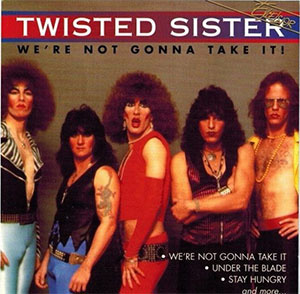
A favorite for cymbal veracity is the Twisted Sister anthem “We’re Not Going To Take It!” The “brass” of the cymbal in this particular cut should put you front stage with absolutely no doubt as to the way the cymbal “rides over” the roar of the singers and amps. I’ve heard similar music played over a far more expensive system (demoed at a regional audio salon) consisting of a Wadia DAC, Audio Research preamp with tube mono-block amps, and B&W speakers.
The cymbals were pathetic. There were plenty of high frequency overtones, but the system badly missed the brass fundamentals. When I tell you that the modestly-priced JBLs stomp all over the fancier rig in this region, you should believe it! And the Stage A180 treble goodness was consistent regardless of the amplifier I used. Bravo JBL!
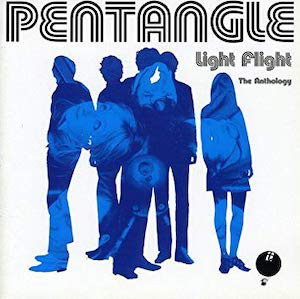
I like complex music to see if a speaker system can separate out the different melodic lines. One of my favorite test discs for midrange separation is two-disc release of The Pentangle’s “Light Flight” anthology on the “Castle Music” label (CMDDD1283). The music produced by the Pentangle is often complex and unless speakers have exceptional resolving power, the presentation can devolve into “audio mush.”
I’m happy to say that the JBL Stage A180s were exceptionally good at resolving detail and allowing one to “hear into the recording.”
This was another area where the JBLs surprised me. I tried the speakers with their backs parallel to the back wall, with the speakers toed in toward the listener at a variety of angles, and even with the face of the speakers slightly toed out from the listener! No matter what I tried, the speakers imaged well and although they lacked the “holographic” soundstage that I’ve heard from some point-source radiators (such as the KEF LS50), the imaging was better than the majority of speakers that I’ve heard. Would they perform as well in a room that was not symmetrical from right to left? Probably not, but that’s what room correction software is for. For my listening, by the way, I did NOT incorporate any correction or frequency equalization.

Once again, I chose the award-winning La La Land for its clean soundtrack and Arrival for its fabled low-frequency effects. The JBL Stage A180 speakers (even without a subwoofer) delivered the clean and intelligible sound that I expected from La La Land and the thundering bass that I expected from Arrival without a hitch. The JBLs also blended gracefully with my (non-JBL) center channel speaker and surrounds.
As mentioned before, the bass performance of the speakers varied more than usual depending on the amplifier used. I wouldn’t say that this was necessarily a “weakness,” but I would say that an audition prior to purchase (preferably with the amplifier that you’re planning to use) might be prudent.
Secrets Sponsor
A second artifact that was occasionally noticeable was that, while some recordings had proper “presence,” other recordings sounded as if the singers were slightly farther back in the soundstage than they should be. Is this an artifact of the recordings, or of the speakers? To test the theory, I tried two other pairs of speakers (the Wharfdales and the Thiels) with the same recordings. The Thiels very rarely displayed the “recessed vocalists” artifact that I could tell, while the Wharfdales did slightly more frequently, but still not as often as did the A180s. Go figure! I’d maybe again attribute this to system matching, but since the effect is not frequent and is very minor, I’m willing to ignore it. And after all, such artifacts are common, to one extent or another, with most ANY speaker, regardless of price.
To evaluate the JBL’s frequency response, I used a calibrated UMIK-1 microphone and “Room Equalization Wizard” software, the following curves were done with the mic one meter from the front of the speakers (grills off), and at the vertical and horizontal center of the cabinets.
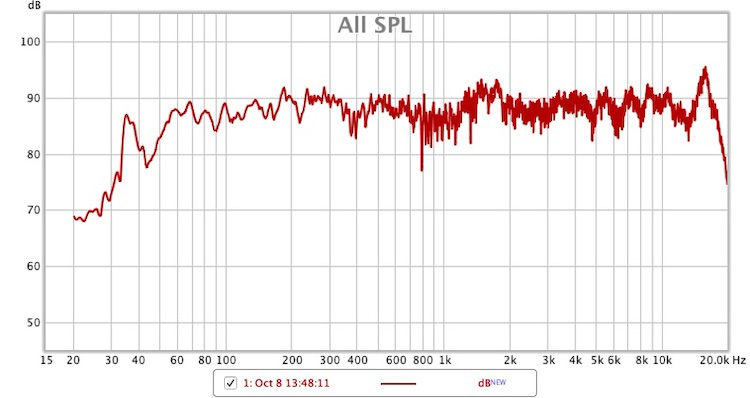
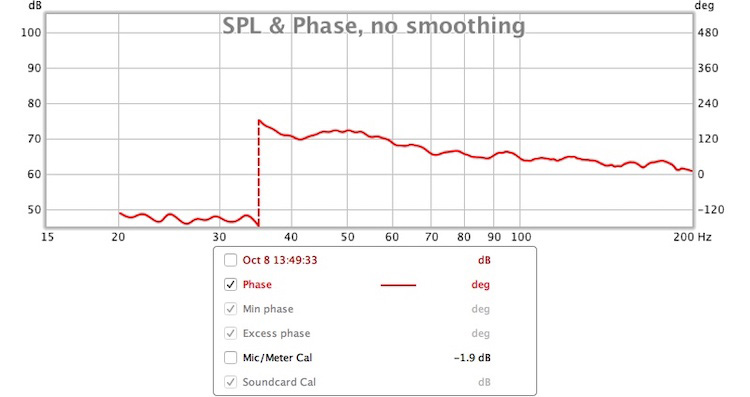
Viewing the curves, I would conclude that the speaker has good bass extension with audible output as low as 35Hz. There seems to be a slight resonance band in the tweeter at about 17KHz. This is not unusual for metal dome tweeters and is not audible when listening to music.
The JBL STUDIO A180 TOWER LOUDSPEAKERS represent a blend of 1970s fun and 2018 technology. Competitive with any other speaker in its price range!
- Construction is better than most, especially at this price point
- Treble is better than expected, rivaling ribbons for clarity
- Outriggers are included
- Both rubber feet and spikes are included
- Some way to reduce and tighten the bass for smaller rooms
- Magnetic grills instead of the post-and-hole mounting
- More finish options (although the wood vinyl does look attractive)
How Harman International manages to pack so much audio goodness into the JBL Stage A180 speakers for so modest a price just amazes me. The approximate $1,000/pair price range of the loudspeaker world is becoming more and more crowded. And I’ve yet to hear a bad-sounding pair of speakers in this category. But despite that, the truth remains that not a single pair of $1K speakers sounds the same as any other. Subtle differences abound. But the specific virtues of the JBLs can’t be ignored. Their excellent treble and ability to play cleanly and loudly even in large rooms must be considered.
The two best speakers that I’ve heard in the $1K per pair range to date would be the Emotiva T2 speakers and these JBL Stage A180s. A slight advantage to the Emotivas for their fantastic ribbon tweeter and midrange detail, but a slight advantage to the JBLs for their price. You can’t go wrong either way!
I’d also point out that the JBL-branded speakers are sometimes discounted by retailers, so the list price might be bettered by judicious shopping.


